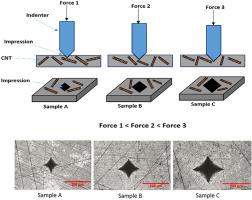Composites Part B: Engineering ( IF 13.1 ) Pub Date : 2020-11-04 , DOI: 10.1016/j.compositesb.2020.108479 Mohammed Al-Bahrani , Alistair Cree

|
Self-sensing nanocomposites based on multi-walled carbon nanotubes (MWCNTs) offer a remarkable range of properties and can be used successfully for many important industrial and engineering applications. Here, we demonstrate the performance of these nanocomposites material when subjected to structural damage at the micro-scale level. Nanocomposite specimens containing different weight % of MWCNTs were prepared using a hot pressing technique. The homogenous distribution of the MWCNTs inside the nanocomposite matrix was investigated using both scanning electron microscopy (SEM) and Raman spectroscopic techniques. The self-sensing nanocomposite specimens were indented to produce sub-surface damage using a Vickers nano-indentation test. The change in the electrical resistance was measured experimentally after each indentation event in order to establish and understand, the structural behaviour of the specimen following the micro-damage incurred. The experimental results show that adding MWCNTs can effectively enhance the electrical and mechanical properties of the nanocomposite materials. Hardness and electrical conductivity increased with increasing MWCNTs concentrations, reaching the highest values at 4.0 wt% MWCNTs. Accompanying these changes both the indentation depth and the defined plasticity index was observed to decrease. Moreover, changes in the electrical resistance of the specimens and the permanent electric damage parameter (β) values also increased with increases in the applied indentation load. A simple micro-scale model is suggested to predict the change in resistance caused by the micro-indentation damage. The results obtained from this model correlate well with the results obtained from the experimental tests. Therefore, it is speculated that the suggested model can be used to predict the damage in a structure in a self-sensing manner, for damage occurring at the micro-scale level.
中文翻译:

自感纳米复合材料基碳纳米管的微尺度损伤感测
基于多壁碳纳米管(MWCNT)的自感应纳米复合材料具有非凡的性能,可成功用于许多重要的工业和工程应用。在这里,我们证明了这些纳米复合材料在微观水平上受到结构破坏时的性能。使用热压技术制备了包含不同重量百分比的MWCNT的纳米复合材料样品。使用扫描电子显微镜(SEM)和拉曼光谱技术研究了纳米复合材料基体内MWCNT的均匀分布。使用维氏纳米压痕测试,将自感应纳米复合材料样品压痕以产生亚表面损伤。在每次压痕事件之后,通过实验测量电阻的变化,以建立和理解发生微损伤后的样品结构行为。实验结果表明,添加碳纳米管可以有效提高纳米复合材料的电学和力学性能。硬度和电导率随MWCNTs浓度的增加而增加,在MWCNTs为4.0 wt%时达到最高值。伴随这些变化,压痕深度和限定的可塑性指数均降低。而且,随着施加的压痕载荷的增加,样品的电阻和永久性电损伤参数(β)值的变化也增加。建议使用简单的微型模型来预测由微压痕损坏引起的电阻变化。从该模型获得的结果与从实验测试获得的结果非常相关。因此,推测所建议的模型可以用于以自感测的方式预测在微观尺度上发生的损伤中的结构损伤。



























 京公网安备 11010802027423号
京公网安备 11010802027423号